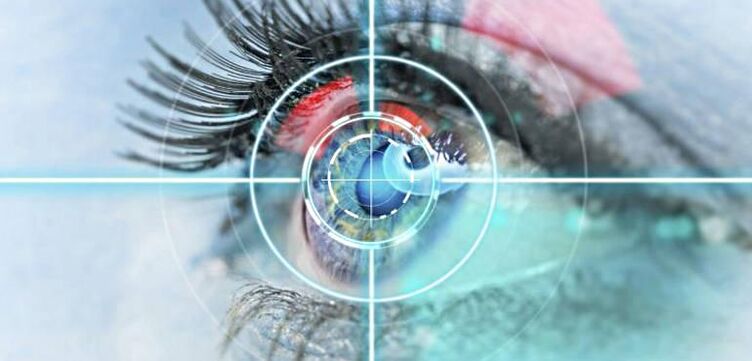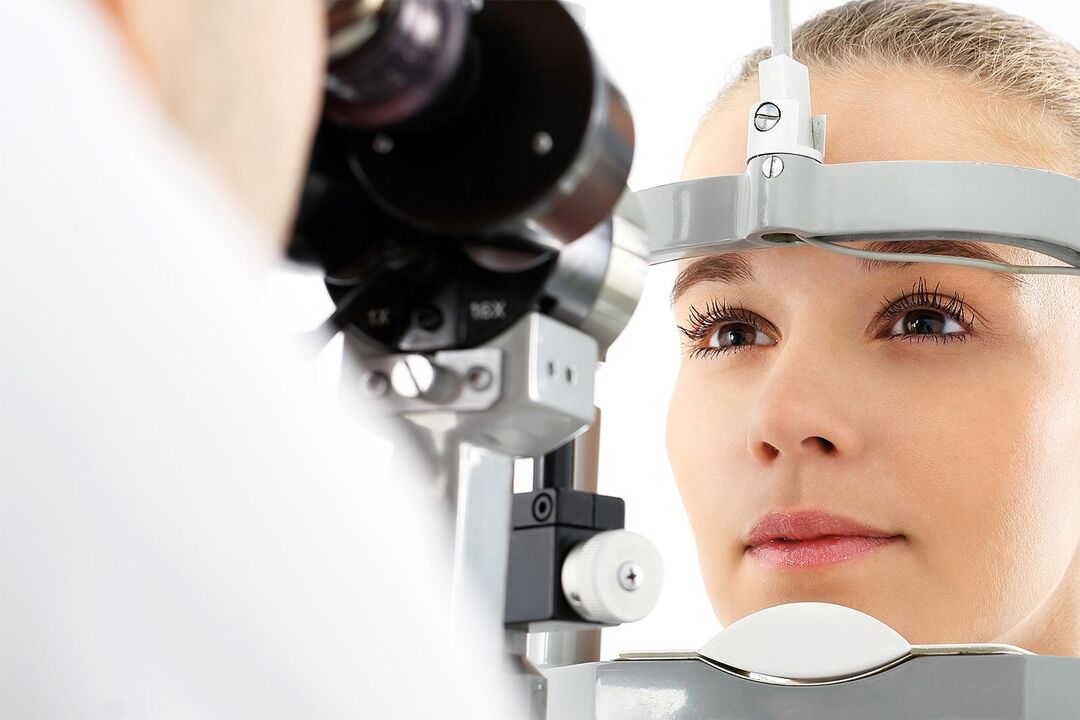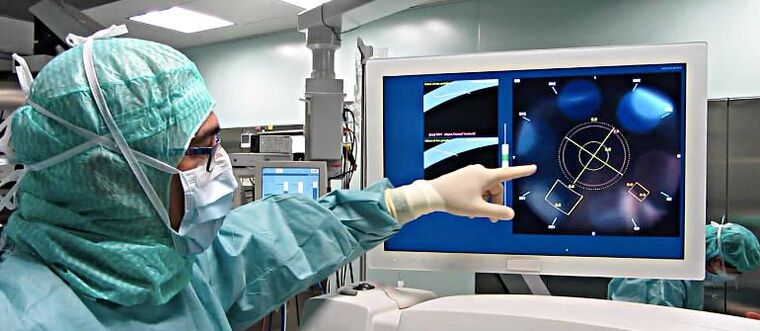Excimer laser surgery changes the geometry of the cornea. As a result of such an operation, the human optical system becomes more perfect and the patient no longer needs to use optical correction products (glasses or contact lenses).
It is important to note that during surgical treatment of ametropia, the refractive power of the retina changes, as a result of which the rays of the image are clearly focused in the macular zone. At the same time, vision becomes significantly better.

Why does vision decrease?
Refraction refers to the optical performance of the entire eye. Refraction is usually expressed in diopters. When this function is impaired, visual acuity decreases, leading to a deterioration in quality of life.
Astigmatism, myopia and farsightedness are in all cases accompanied by a decrease in visual acuity. Any refractive error means that the focal point of the rays is not in the plane of the retina, but in front of or behind it. Therefore, such patients require correction of visual function using external optical devices (glasses or contact lenses). This need can cause some inconvenience and is sometimes unsafe.
Among the diseases associated with refractive error, myopia is the most common. According to statistics, a third of all Earth's inhabitants suffer from myopia. This disease can be diagnosed at any age, but myopia is most often diagnosed between the ages of 8 and 16. In the future, the disease may stabilize or progress further. In any case, myopia affects the quality of life, causes discomfort to the patient and therefore requires special attention from specialists.
It should be noted that any visual impairment requires mandatory correction. Many people believe that using glasses to correct vision reduces visual acuity, but this is not true. On the contrary, if you do not use corrective methods, your eyes may stop working, which will certainly lead to amblyopia over time. In this case, even with perfect vision correction, it will not be 100%
Why do you need laser vision correction?
Due to the fact that many people suffer from refractive errors (farsightedness, astigmatism, myopia), specialists are constantly developing new methods for effective treatment. One of the new methods that are highly effective for ametropia is laser restoration of visual function.
Although both glasses and contact lenses are widely available, easy to use, and affordable, several thousand people turn to specialists every day requesting laser vision correction.
It's easy to explain why this happens. Firstly, even the most modern glasses cause their owner some inconvenience. Wearing it for a long time creates pressure on the bridge of the nose and ears, which is sometimes accompanied by pain. Wearing glasses is also very uncomfortable in winter, as if there is a sharp change in temperature in a warm room, the glasses will immediately fog up. In addition, glasses not only cause discomfort during active sports, but can also be dangerous.
Glasses, like contact lenses, can be forgotten or lost, so prudent people always have an extra pair for backup.
If you choose the right contact lenses, they will undoubtedly cause less discomfort. For example, the lenses do not fog up, do not put pressure on the bridge of the nose and are comfortable during active activities. However, when using any lenses, even the most modern ones, the oxygen concentration in the corneal cells decreases. As a result, vessels from the underlying layers begin to grow into the cornea, and over time dry eye syndrome can also develop. Irreversible changes to the eye usually occur 5-10 years after you start using contact lenses. Afterwards, patients often have to switch to glasses or look for another alternative.
Laser correction of refractive errors helps the patient to forever do without contact lenses and glasses, so this treatment ensures a high standard of living.
It is important to note that not all patients are suitable for laser treatment of ametropia. For example, laser correction cannot be performed on children under 18 years of age because their eyeball has not yet finished growing. For this group of patients, glasses and contact lenses are the only way to improve visual acuity. In this case, it is important to wear the lenses correctly so as not to cause irreversible changes to the cornea. An ophthalmologist will help you if you visit him regularly and monitor the dynamics of changes in vision.

Preoperative preparation for laser vision correction
In order to undergo laser vision correction surgery, you must first undergo a comprehensive ophthalmological examination. When making a diagnosis, the doctor assesses the condition of the eyeball as a whole and all of its structures individually. In addition, many important parameters are measured.
The main diagnostic methods include:
- visometry, i. e. measurement of visual acuity;
- Pneumotonometry, necessary to determine intraocular pressure;
- pachymetry, which measures the thickness of the cornea;
- autorefractometry, in which the refraction of the eye is determined automatically;
- Echo biometry required to measure eye length;
- Perimetry, i. e. determining the boundaries of the field of vision;
- The Schrimer test is necessary to assess the amount of tears produced;
- Computer topographic analysis of the cornea, a modern method for elucidating the structure of the cornea;
- Examination of the fundus structures after preliminary maximum mydriasis using medical drops.
After careful preoperative preparation and diagnostics, the doctor can say with a high degree of certainty what results the patient can expect after laser correction. This also allows you to avoid the most common complications in the postoperative period.
How is laser vision correction performed?
During the operation, a minimally invasive procedure is carried out on the substance of the cornea, which leads to a change in the curvature of the corneal surface.
After the doctor corrects the shape of the cornea with an excimer laser, the rays of the image converge at a point that lies exactly in the plane of the retina. All methods used in modern medicine are very safe, accurate and ensure high visual acuity.
Laser vision correction itself takes about 10-15 minutes on average. The operation uses local anesthesia, which is carried out with special eye drops. This allows you to minimize pain both during the procedure and after it. After the operation is completed, the patient is observed in the clinic for approximately one and a half hours. Then the patient is sent home, having previously given all the recommendations. It is important to note that laser vision correction surgery has practically no effect on the patient's rhythm of life, i. e. h. the restrictions in the postoperative phase are minimal.
Already at the stage of a complete medical examination, the doctor gives all the explanations about the peculiarities of the preoperative and recovery periods. To systematize this information, there are very practical reminders in which the patient will find answers to all his questions.
Benefits of vision restoration with excimer laser
Vision correction with an excimer laser is a widespread procedure that is in demand in all countries.
The advantages of the method include:
- reliability of results;
- Painless;
- speed of execution (no more than a quarter of an hour);
- Security;
- Outpatient implementation of manipulations;
- Wide range of options;
- Short recovery period;
- Predictable and predictable result with high accuracy;
- No cuts or stitches;
- simplicity and accessibility;
- No additional testing is required.
- High efficiency that lasts a lifetime.
It should be noted that, despite the wide range of options for laser vision correction, this operation is not a guarantee that various eye diseases will not occur in the future.

Contraindications to laser vision restoration
Unfortunately, it is not always possible to carry out laser correction of visual function. All contraindications to this operation can be divided into two large groups: temporary and permanent. Among temporary contraindications, the most common are reversible diseases of the eye (or the entire body). After these diseases have been cured, laser correction is quite possible. Temporary contraindications include:
- Progressive myopia, as the refraction is not stable;
- Acute inflammatory changes, both in the eye itself and in other body systems;
- Pregnancy;
- lactation;
- changes in the fundus of the eye, including ruptures and dystrophic changes;
- Degenerative processes in corneal cells.
If there are constant contraindications, laser vision correction is impossible. This includes:
- Thin cornea;
- Glaucoma;
- lens subluxation;
- retinal detachment;
- Cataract;
- Decompensated diabetes mellitus;
- Previous surgical treatment of a retinal detachment.
Interestingly, even if there are absolute contraindications to laser vision correction, you can choose an effective alternative method of treatment that will help restore vision.
The main differences between laser surgery and other techniques
Laser correction of refractive errors includes several types. After reading the name, most patients do not understand the essence of the operation because abbreviations or established terms are predominantly used. A distinctive feature of SuperLASIK's REIC and LASIK surgeries is the second phase of the surgery, where a femtosecond laser is incorporated into the process.
The term SuperLASIK used in practice is not entirely accurate, as patients may think that the traditional LASIK technique is somehow inferior and inferior to it. In foreign literature, a more correct term is used (custom LASIK). Translated, this operation should be called personalized LASIK. This does not mean that traditional LASIK surgery has any disadvantages. However, in some special cases it is better to carry out SuperLASIK, while in other situations you can limit yourself to a simple LASIK operation. That is why when choosing a method for laser vision correction, an individual approach should be taken, taking into account the data of the preoperative examination.
An important difference between FemtoLASIK and traditional laser correction is that the operation is completely non-contact. The first step of cutting the superficial corneal flap with a microkeratome blade is performed with a femtosecond laser in FemtoLASIK. This technique is quite new, so there is not yet sufficient experience to clearly determine its effectiveness and safety.
Some doctors believe that the femtosecond laser is much safer than a microkeratome, but other specialists do not agree with this statement and prefer mechanical formation of the flap.
Another new method of laser vision correction is the Smail operation. This procedure uses only a femtosecond laser and eliminates the phase of forming a surface flap from corneal tissue. In this case, a refractive section is immediately created in the deep layers of the cornea. The latter is removed using a special instrument through a minimal incision (2-4 mm) in the superficial layers of the cornea. This cut is also done with a femtosecond laser.
It is very important to understand that vision and eyes are one of the most important tools for human interaction with the outside world. Few people can disagree that a person needs eyes constantly, that is, 365 days a year. That's why it's so important to take care of them from a young age.

























